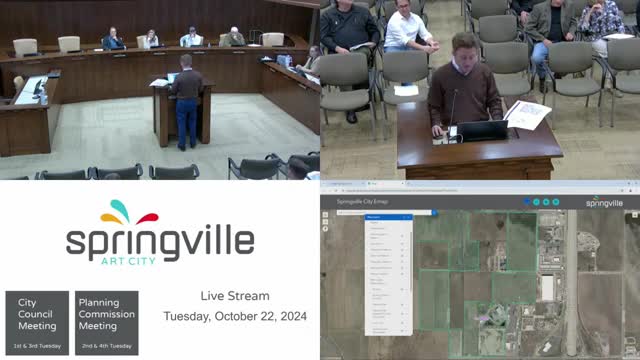Lakeside Landing plan revision faces scrutiny from staff and community stakeholders
November 16, 2024 | Springville City Council, Springville, Utah County, Utah
This article was created by AI summarizing key points discussed. AI makes mistakes, so for full details and context, please refer to the video of the full meeting. Please report any errors so we can fix them. Report an error »

The Springville City Council held a meeting on November 16, 2024, to discuss significant developments within the Lakeside Landing District, focusing on amendments to the existing development plan and zoning regulations. The meeting addressed the ongoing evolution of the district, which has seen the addition of approximately 15 acres and the establishment of three subdivisions, with a fourth currently under development.
Key discussions centered around proposed amendments brought forth by UBA, the consulting firm responsible for the district's planning. The council noted that the new proposals diverged significantly from the original plan, which had undergone extensive collaboration and review. Concerns were raised regarding the potential impact of these changes on the overall vision for Lakeside Landing, particularly its designation as a walkable and vibrant community center.
The council reviewed the current zoning classifications, specifically the transition from a T6 to a T5 transect. The T6 area, designated as the urban center, allows for a higher density of residential and commercial units, while the T5 area permits a broader range of lot types but with a reduced maximum unit count. The original plan entailed a maximum of 516 housing units, whereas the new proposal would limit this to 331 units, reflecting a significant decrease in density.
City staff expressed support for the concept of reducing density in new developments but cautioned that altering the core of the Lakeside Landing plan could undermine its foundational goals. The council emphasized the importance of maintaining the integrity of the original vision, which aims to foster a diverse and vibrant neighborhood.
The meeting concluded with a commitment to further dialogue between the city staff and the applicant to address the outlined concerns and ensure that any amendments align with the community's long-term objectives. The council plans to continue reviewing the proposals in upcoming sessions, with a focus on balancing development needs with the preservation of community character.
Key discussions centered around proposed amendments brought forth by UBA, the consulting firm responsible for the district's planning. The council noted that the new proposals diverged significantly from the original plan, which had undergone extensive collaboration and review. Concerns were raised regarding the potential impact of these changes on the overall vision for Lakeside Landing, particularly its designation as a walkable and vibrant community center.
The council reviewed the current zoning classifications, specifically the transition from a T6 to a T5 transect. The T6 area, designated as the urban center, allows for a higher density of residential and commercial units, while the T5 area permits a broader range of lot types but with a reduced maximum unit count. The original plan entailed a maximum of 516 housing units, whereas the new proposal would limit this to 331 units, reflecting a significant decrease in density.
City staff expressed support for the concept of reducing density in new developments but cautioned that altering the core of the Lakeside Landing plan could undermine its foundational goals. The council emphasized the importance of maintaining the integrity of the original vision, which aims to foster a diverse and vibrant neighborhood.
The meeting concluded with a commitment to further dialogue between the city staff and the applicant to address the outlined concerns and ensure that any amendments align with the community's long-term objectives. The council plans to continue reviewing the proposals in upcoming sessions, with a focus on balancing development needs with the preservation of community character.
View full meeting
This article is based on a recent meeting—watch the full video and explore the complete transcript for deeper insights into the discussion.
View full meeting

